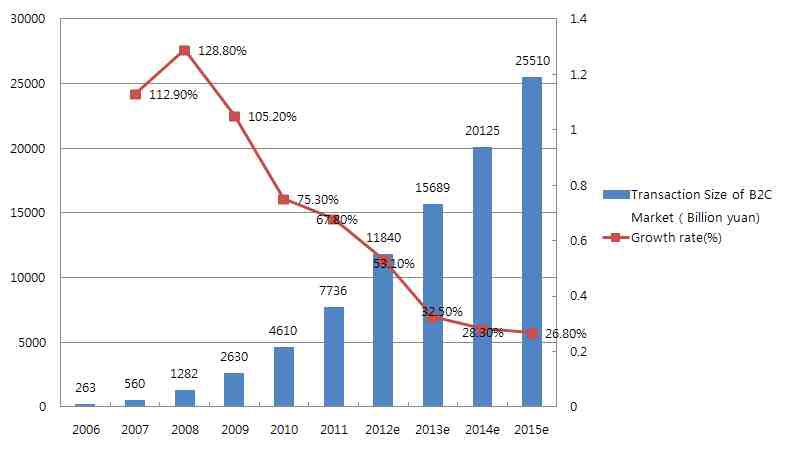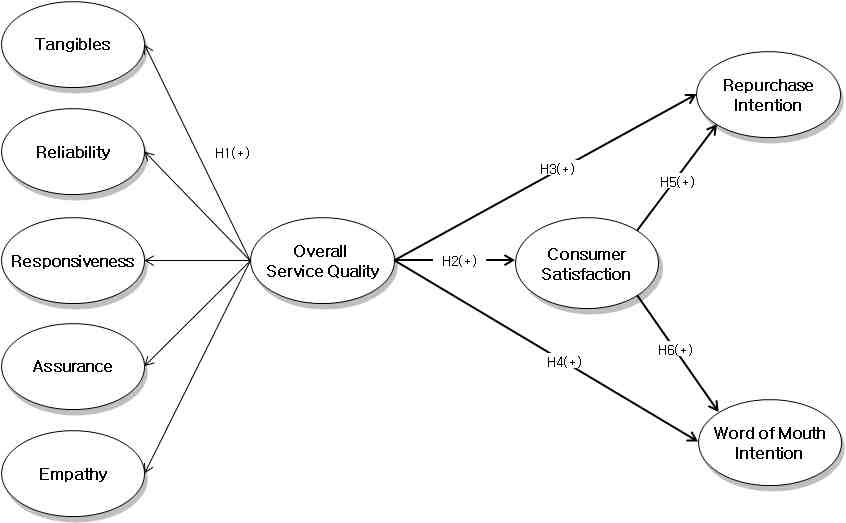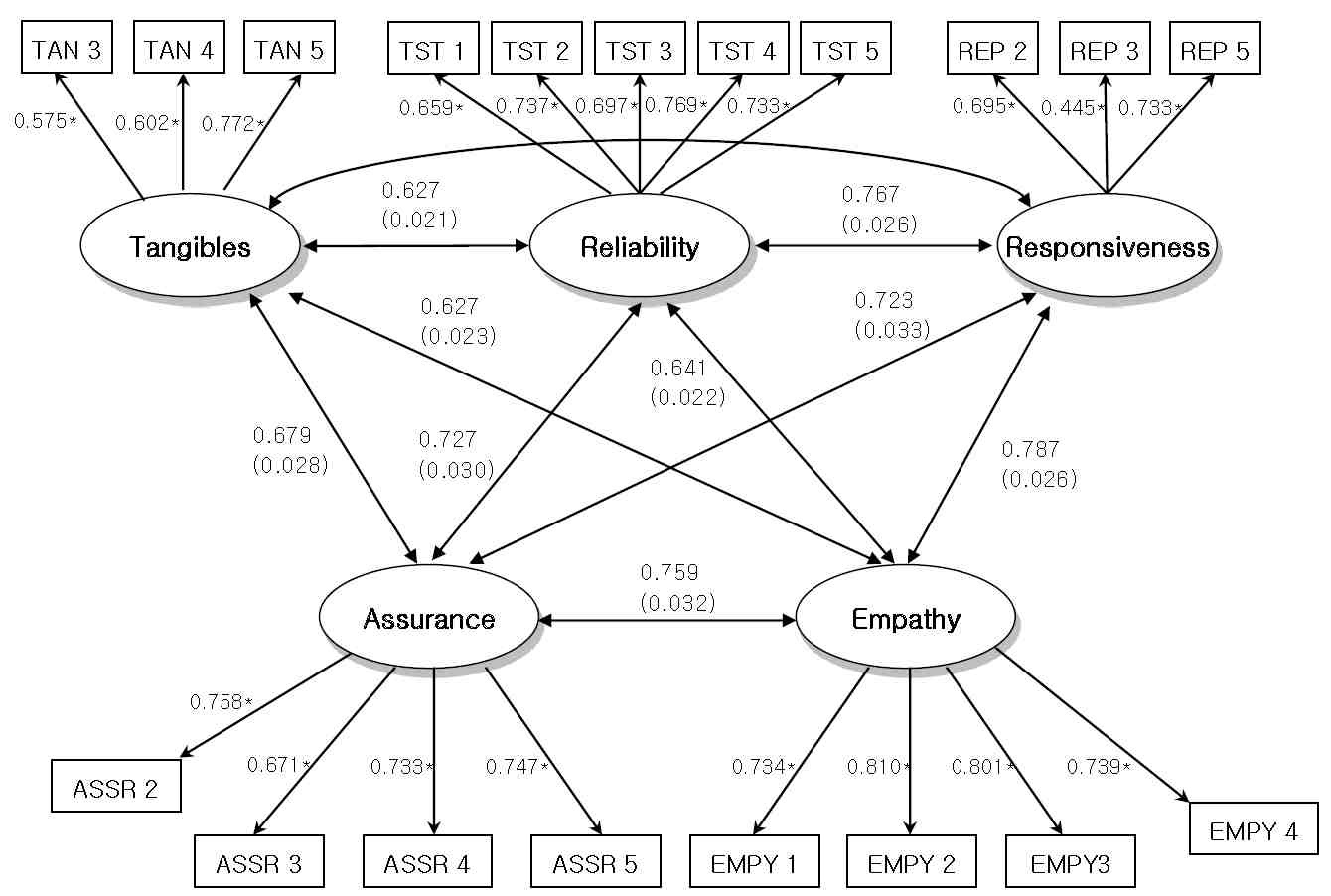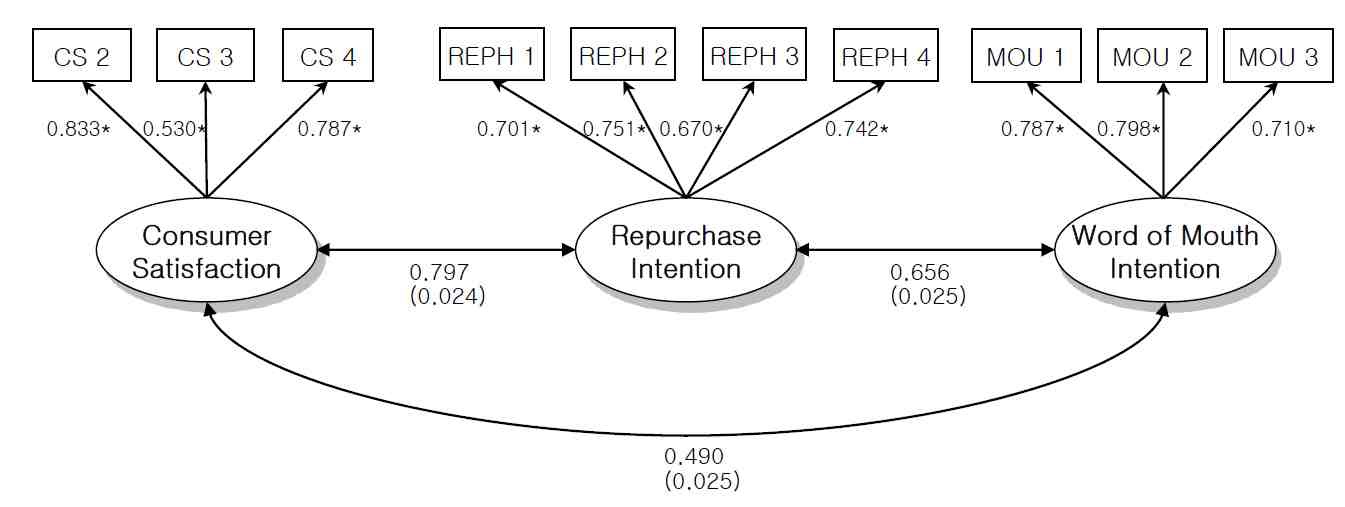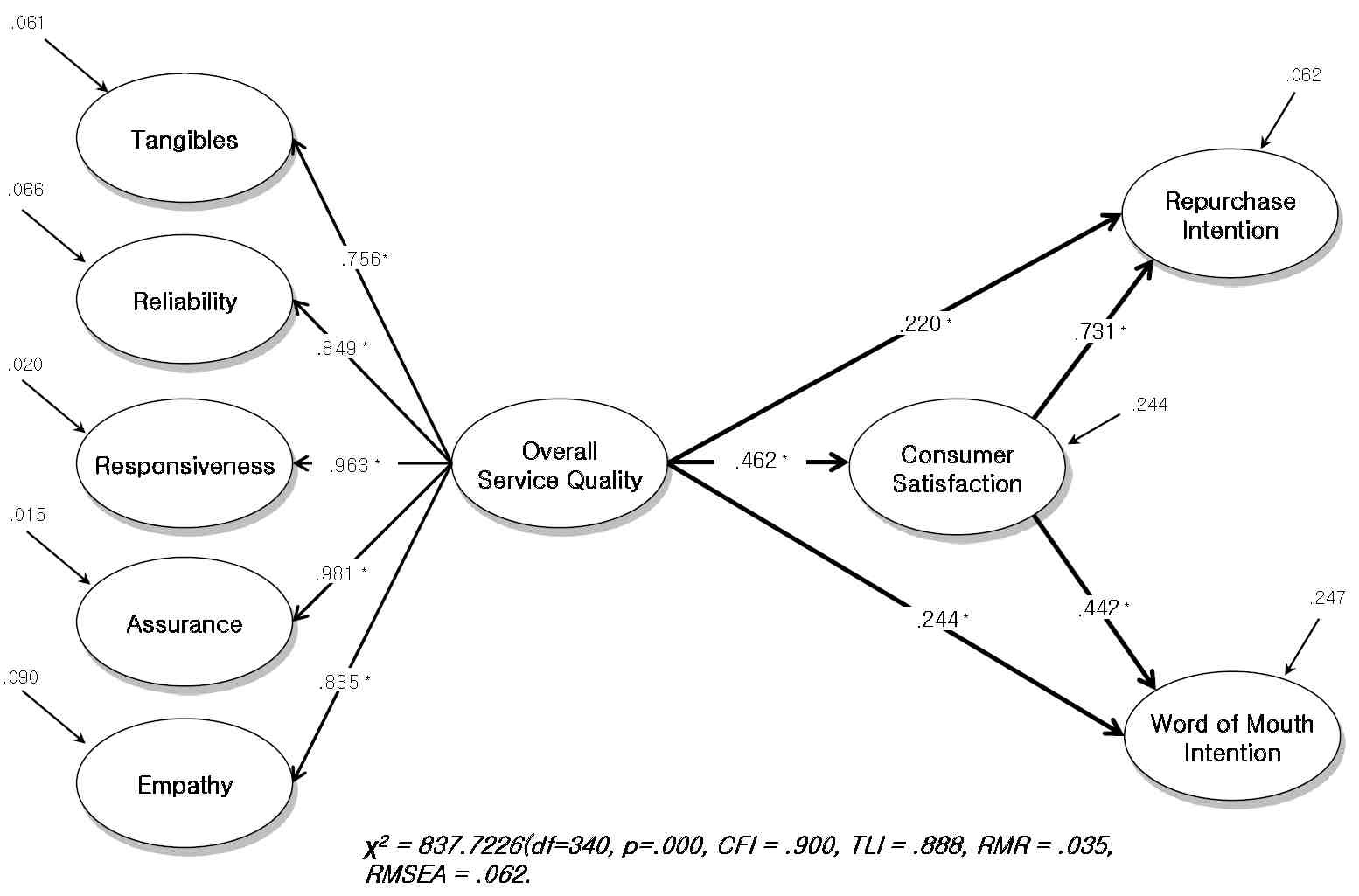


Internet shopping malls dominate bricks-and-mortar stores through their innate nature of providing a greater variety of products and services at lower prices, at the convenience of consumers. Like all the other countries in the world, China is no exception in that the Internet plays a significant role as a new distribution channel. Due to the great potential of China to become one of the biggest on-line marketplaces, countries from all over the world have entered into Chinese Internet shopping malls. Internet shopping malls in China are rapidly transforming from a blue to red ocean these days due to the fierce competition in the marketplace. To be successful in the Chinese on-line marketplace, positioning matters more than the right targeting. Those who stand out from the offerers and who can plant unique product and service concepts in a consumer's mind performs better. Overall, it's rather more important on what you do with the minds of the prospects rather than what you do with the product.
From the scale of market entities which explains the range of products along a continuum based on their tangibility, goods are tangible dominant and services are intangible dominant. Therefore, all products are composed of varying degrees of both tangible and intangible characteristics (Shostack, 1977). From this view point, if products seemingly are a bundle of tangible and intangible elements with varying degrees of combinations, the tangible aspects of an intangible dominant product and intangible aspects of a tangible dominant product can be a significant source of product differentiation and thereby create new revenue streams (Hoffman and Bateson, 2006). This significant notion triggered the initiation of our research investigating the intangible nature of on-line product offerings. Thus the measurement tool for service quality, the SERVQUAL, and its influence on the consumer reaction are considered for investigation.
A number of recent studies explore the causal linkage between Internet shopping mall characteristics to customer performance (Zang, et al., 2011), shopping mall usage patterns (Han et al., 2005; Hong et al., 2009), and consumer propensity on shopping-mall performance (Park, 2005). Yoon et al.(2011) extracted e-Satisfaction determinants by comparing the Internet shopping environment between China and Korea. Based on the study of Brady and Cronnin(2001), Choi and Joo(2011) conducted a study on the service quality of Internet shopping malls. They differentiated quality into three levels: physical environment, interaction, and outcome to justify consumer performance. Suh et al.(2007) differentiated the quality of Internet shopping in China into three areas: information, system, and service. These studies utilized various different characteristics from shopping malls and the innate nature of consumers to understand their business performance in the Internet environment. However, the generalized results of these studies are limited due to the differences of study designs and outcomes. Therefore, rather than creating another set of quality measures, we have decided to base our study on the hierarchical structure of SERVQUAL to initiate and apply it to the Chinese context.
The current study looks at five service quality elements (called SERVQUAL), tangibility, reliability, responsiveness, assurance, and empathy, that were suggested by Parasuraman et al.(1988) to assess whether these measures are applicable to the Internet shopping environment. As a part of the recent study trend of defining the hierarchical structure of SERVQUAL, our paper investigates whether the overall service quality measure can be a good representation of those five dimensions and ultimately have influence on consumer satisfaction, repurchase intention, and WOM (word of mouth).
1. Outline of Chinese Internet Shopping Malls
An Internet shopping mall has an optimal distribution structure. The outstanding convenience and cost-saving characteristics of its innate nature are additional attractions to bring people into the business. There are about 2 million people utilizing this business in China. Therefore, it is important to understand the future direction of the Internet business by observing how the business is growing and flowing in the Chinese environment.
As suggested in <Figure 1>, the growing rate after 2008 has been decreasing. However, the transaction size of B2C has been dramatically increasing. The economic decline has driven customers to utilize more Internet business due to the benefits of savings. As giant B2C distribution companies emerge, this trend is more prevailing in the cosmetic and fashion industries in particular.1
2. Service Quality in Internet Shopping Malls
Traditionally, the studies on the service quality in the marketplace were focused on bricks-and-mortar stores. It was not until the latter half of the 1990s that the focus was transferred to on-line marketplaces. The initial service quality studies were on the differences between consumer expectations about the service and the actual performance of the sites. However, in the on-line service environment, these perceptual differences shifted to real time perceptions in terms of the tangibles they provide and the whole process of supporting them to end consumers.
The studies of Lalonde et al.(1976), Parasuraman et al.(1985), and Mentzer et al.(2001) are the major ones in the field of service quality. Lalonde et al.(1976) and Ballou(1985) studied the influencing factors before transactions began between the service provider and consumer, what happened during the transactions, and the post-transaction period. The factors prior to the transactions are documentation of service policy, system flexibility, and other non-directive distributive marketing activities. The factors relating to the transactions in progression are level of inventory quality, orders, transportation, system accuracy, and administration of orders. The factors after transactions are product recovery, follow-up service, returns, and are claimed to have great impact on consumer repurchase intentions.
Parasuraman et al.(1985) suggested ten subordinate dimensions of service quality. They are reliability, responsiveness, competence, access, courtesy, communication, credibility, security, understanding/knowing the customer, and tangibles. These ten sub-dimensions of service quality play as the major frame that constitutes the framework of the SERVQUAL model. The five dimensions of service quality suggested by Parasuraman et al.(1988) are tangibility, reliability, empathy, assurance, and responsiveness, but there are no clear cut boundaries of the attributes each of them has. For instance, Carman (1990) studied the validity and applicability of the SERVQUAL tool on dental clinics, vocational offices in universities, tire stores, and emergency rooms in hospitals. However, the process of developing a SERVQUAL tool in each target market are not identical processes which can be shared each other. This is due to methodological issues and data collection procedures. Also, the distinctive characteristic each target market plays a role in their differences (Lee and Lee, 2001).
Grönroos(1984) distinguished service quality into technological and functional dimensions. The technological dimension refers to the qualities of the end product consumers use, meaning the quality of "what." The functional dimension refers to the procedural quality of service, meaning "how." Lee and Lee(1997) suggested that if Grönroos's study is compared to that of Parasuraman et al.(1988)'s five dimensions, the functional dimension is the equivalent to tangibility, responsiveness, assurance, and empathy while the technological dimension is only relevant to reliability. Therefore, most of subordinate measures of SERVQUAL are focused on procedural quality factors. Brady and Cronin(2001) developed a three-dimensional model of hierarchical service quality that includes a physical environment quality, interaction quality, and outcome quality. They adopted the work of Rust and Oliver(1994) who claimed that the perception of service quality is based on a three-dimensional evaluation at the time of the service transaction. Also the work of Dabholkar, Thorpe, and Rentz(1996) was adopted in which they claim that quality of service is based on multi-dimensional and multi-attributes.
The correlation index among subordinates of service quality is relatively high, and it is not easy to organize them according to the result of the exploratory factor analysis. This is a major reason why service quality is considered to be a hierarchical construct (Brady and Cronin, 2001; Dabholkar et al., 1996).
3. Consumer Satisfaction and Behavioral Intention
1) Consumer Satisfaction
Patterson et al.(1993) claimed that continuous high service quality is indeed a major influencer of consumer satisfaction. Yet the perceptual difference between the service received in the past and the one being received now works as a higher influencer. Oliver(1977) noted that the following factors are significant influencers of consumer satisfaction: reliance on the personal experience of service, attribute and dimension, perception and emotion, antecedents of constructs, and time factors. It is not clear on the relational factors between service quality and consumer satisfaction in the Internet environment. However, most studies suggest perceptual measures of the service quality are the major influencers on consumer satisfaction.
2) Behavioral Intention
It has been said from prior researches that one of the strong possible outcomes of consumer satisfaction is a repurchase intention. Oliver(1980) suggested that consumer satisfaction influences post-purchase behavior, and this behavior influences the repurchase intention. Chae(2005) suggested product attributes, price, level of service, and advertising lead to consumer satisfaction and repurchase intention. Jeon(2009) studied the motivations of wine purchasing and its choice attributes. He found out that the high level of consumer satisfaction influenced the repurchase intention. It is assumed that in the Internet environment, consumer satisfaction occurs after a consumer has done the evaluation of the service provided. Jang et al.(2009) proved that consumer satisfaction in the Internet environment led directly into word of mouth (WOM) and repurchase intention, or so called e-loyalty. They emphasized that consumer satisfaction is extremely significant in enhancing e-loyalty. Kim (2008) found that consumer satisfaction in the Internet environment leads to word of mouth (WOM), repurchase intention, and loyalty. The current study adopts repurchase intention and word of mouth (WOM) as the primary descendents of the consumer satisfaction suggested by the prior studies.
1http://www.globalwindow.org/wps.
This study is introduced according to the recent research trend of defining the hierarchical structure of the SERVQUAL model. The hierarchical structure of the model is to verify whether the underlying dimensions of SERVQUAL by Parasuraman et al.(1988), which are tangibility, reliability, responsiveness, assurance, and empathy, can appropriately represent the overall measure of service quality. The reason for the hierarchical structure must be under consideration in the service quality studies where the service quality is mutidimentional and of a hierarchical structure(Brady and Cronin, 2001). In addition, our study also investigates whether the overall measure has a significant impact on consumer satisfaction and behavioral intentions, repurchase intentions and word of mouth. The illustration of the study model is depicted below <Figure 2>.
1) Structural Relationship of Service Quality in Internet Shopping Malls
According to the study of Parasuraman et al.(1988), the individual dimensions of SERVQUAL tends to have high correlations with each other and, therefore, are not easy to separate one subordinate dimension from the other by just using exploratory factor analysis techniques. Recently the researchers began suggesting a second-order structure of the SERVQUAL measure due to the innate nature of the hierarchical structure of the measure (Brady and Cronin, 2001; Dabholkar, Thorpe and Rentz, 1996). Lai(2006) defined, through his study of the e-business service environment, that only four dimensions of SERVQUAL exist as the forms of reliability, responsiveness, assurance, and empathy. He claimed that these four independent domains of measure can be represented as Eb-SERVQUAL, which is simply put as the overall service quality measure. Likewise, Martin and Ibrahim(2006), through their study on e-service quality, reported that on-line service quality can be represented by QES (Quality of Electronic Service) which is short for environment quality, delivery quality, and result or outcome quality. He also claimed that the service quality in an on-line environment is composed of a hierarchical construct of these three sub-dimensions. From the numerous findings from above, we can conclude that the dimension of e-service quality is composed of a multidimensionality construct and hierarchical order. A similar result can be found in the domestic study conducted by Jeon(2007). Through his study of the hierarchical construct of SERVQUAL, he testified on a formative model versus a reflective one regarding the goodness of fit of the suggested model. As a result, the reflective model, possessing a better model fit, turned out to better represent and explain the actual real service quality than the individual subdimensions.
These previous studies supported that the dimensions of service quality in Internet shopping malls can possibly be composed of a multidimensionality construct and hierarchical order. The current study defines tangibility, reliability, responsiveness, assurance, and empathy as subordinate concepts of overall service quality. And these subordinate concepts are assumed to be better representatives of the overall service quality construct in explaining the subordinate concepts than the overall model. In this way, we can empirically testify as to whether the reflective model suggested by Jeon(2007) does have a better fit than the formative one.
2) The Relationship among Overall Service Quality, Consumer Satisfaction, and Behavioral Intention
According to Parasuraman et al.(1988), perceived quality is the difference between a consumer's expectation and the actual performance of the service being conducted. Therefore, if the level of actual performance of the service exceeds that of the expectation, the quality of service is high and the consumer is in a state of service satisfaction. Park et al.(2010) studied the relationship between the service quality of on-line shopping malls and the level of consumer satisfaction. Their study supported Parasuraman et al.(1988)'s work in that there is a linear relationship between service quality and the level of consumer satisfaction. They suggested that the e-service quality is represented by the easiness of usage, functionality, privacy, and design, and is called process quality. There is another dimension of e-service quality, called outcome quality, which is composed of the state of purchase order, and accuracy. The quality of e-service not only positively influences consumer satisfaction, but also repurchase intention, and the word of mouth of consumers. Jeon et al.(2008), in their study on the relationship between Internet shopping service quality, consumer's satisfaction, and word of mouth, proved that all subordinates of service quality as they defined, such as reliability, variability, convenience, accuracy, and ability to communication, do significantly influence all the dependent variables. The work of Jang et al.(2009) supported that Internet shopping service quality partially influences e-loyalty. Shin(2002)'s work also supported the idea of the Internet shopping service quality influencing consumer loyalty.
Viewing from the previous literature, the current study takes the position that the assumptions of overall Internet service quality significantly influence both consumer satisfaction and behavioral intention.
3) Consumer Satisfaction and Behavioral Intention
The repurchase intention is significant in a sense that long term relationships between consumers and companies can be achieved. Having a long term relationship with a consumer means that earning a consumer's life time contribution on the company's product or service is highly likely to occur. The recent trend in marketing talks about the prevention of losing current consumers is more significant to management because it is more difficult to achieve than attracting new consumers.
Seo(2010) studied the relationships among SNS website quality, consumer satisfaction, and continued usage intention of the site. He found out that these causal relationships do significantly hold. Lee et al.(2006) studied the causal relationship regarding consumer repurchase intentions on e-Learning sites. They found that the subordinates of consumer satisfaction are represented as education contents, brand awareness, administrative aspects, and technical characteristics, and do have a positive significance on the repurchase intention of the service. Bitner(1990) studied the service in an airport. What he had found out was that there exists a positively strong urge for the word of mouth to occur among the people who experienced good quality service.
Another study done by Park and Park(2010) on Internet fashion shopping malls, where they had looked at the relationship between consumer satisfaction and loyalty, also proved that the more you are satisfied with a service, the more you intented to repurchase and say good things about the service to others, ie. the word of mouth.
All can be said from the previous literature that a linear relationship does exist between the level of consumer satisfaction and behavioral intention, whether it's repurchase intention or word of mouth.
The current study was conducted on a target sample population of people who purchase products through Internet shopping malls in China. The data was collected using surveying questionnaires starting from March 2nd until July 15th in 2011. A total of 900 questionnaires were distributed, but only 420 were returned (collection rate, 46.6%). Out of the 420 collected, 33 questionnaires were omitted due to the incompleteness of responses. Therefore, a total of 387 valid questionnaires were used for the study.
Descriptive statistic analyses, such as frequency analysis and a reliability test, were employed to understand the internal validity of the nature of our raw data. To do that, we used the SPSS 12.0 statistical package program. To test our research hypotheses, we used the statistical package, Amos 17.0. For analyzing the structural equation model, we used a covariance matrix. To conduct the goodness of fit test, we employed the following criteria; p value of
4. The Operational Definitions and Measurement of Study Variables
1) The Service Quality of Internet Shopping Malls
Our study was conducted based on the works of Parasuraman et al.(1988) and Javenppa and Todd(1997). Tangibility is defined as "the characteristics of an Internet shopping mall website." To measure this item the following five attributes were extracted: the degree to which an Internet shopping mall has the newest products, the degree of the homepage quality, the level of arrangement of website contents, the degree of attractiveness when selling the products, and finally, the degree of how quick a response can be given back on a consumer's demand for a product.
Reliability is defined as "the response to a consumers request." To measure this item, the following five attributes were extracted: the degree of observing timelines when delivering the product, the degree of resolving any conflicts that may occur after the product was delivered, the degree of safety of the system, the degree of overall trust, and finally, the degree of belief that the Internet site won't do any harm to consumers.
Responsiveness is defined as "how quick a response can be given back on a consumer's demand for a product." To measure this item, the following five attributes were derived: the degree of how quickly an Internet site can provide responses on a consumer's request, the degree which consumers can view the whole process of a product being delivered to a designated destination, the degree of feedback a system can provide to consumers, the degree of feedback a system can provide in verifying the state of a deposit, and finally, the level of how much of a consumer's request is being processed in the way the consumer intended.
Assurance is defined as "the degree to reduce a consumer's negative perception." To measure this item, the following five attributes were derived: the degree of overall trust, the degree of trust in the security system, the degree of kindliness of providing answers to consumer questions, the degree of consumer perception on how ethical the company is to both consumers and society, and finally, the degree of consumer trust in the information provided by the Internet shopping site.
Lastly, empathy is defined as "the ability to understand a consumer's private request and respond the way the consumer wants." To measure this item, the following four attributes were derived: the degree of trying to understand consumer requests, the degree of paying private attention to individual consumers, the degree of considering consumer benefit, and the degree of speculating what consumers want.
All variables were measured using five point Likert scales, ranging from 1 being very unsatisfactory to 5 being very satisfactory.
2) Consumer Satisfaction
The current study conceptualized consumer satisfaction as "the attitude of consumers on the level of need satisfaction." It includes emotional, affective, and cognitive responses from consumers on overall service provision (Oliver, 1997). On the basis of this definition, we defined the consumer satisfaction on an Internet purchase as "the overall level of satisfaction of the consumers after they have experienced the quality of service provided by an Internet shopping mall." Nam(2001) claimed in his study that the core of satisfaction response is the overall level of response. Therefore, the overall measure on satisfaction should never be omitted. Our study followed the opinions of Fornell(1992) and Nam(2001), and the following four attributes were used for the measurement: the level of satisfaction on the purchase over the Internet, the level of satisfaction on the selling over the Internet, the level of satisfaction on the service provided by the Internet shopping mall, and the overall level of satisfaction.
3) Behavioral Intention
The repurchase intention in our study is defined as "the intention to repurchase the same product or service in which the purchase already has occurred." Based on the work of Fornell(1992) and Oliver(1999), we constituted our measurement tool with the following four indicators: the degree of attachment to a certain Internet shopping mall, the degree of trust of a certain Internet shopping mall, the level of a consumer's urge to revisit the Internet site from which they had made a purchase, and the degree which consumers personally want to keep visiting the Internet shopping mall site in the future time frame.
The word of mouth is defined as "the intention which a consumer would like to tell good things about the Internet shopping he/she experienced to other people in a close relationship." Based on the work of Fornell(1992) and Oliver(1999), we constituted our measurement tool with the following three indicators: the level of intention to explain things about the Internet site he/she used to other people with whom they have a close relationship, the level of intention to tell good things about the Internet site he/she used to other people with whom they have a close relationship, and the level of intention to recommend the Internet site he/she used to other people with whom they have a close relationship.
Ⅳ. Results and Implications for Korean Shopping Malls
The descriptive figure of our study sample is the following. We had a total of 387 valid samples for the study, of which 41.6% of the sample is composed of males (161) and 58.4% of the samples are females (226). The geographic areas where our sample population was distributed are 18.8% from Beijing (73), 20.5% from Shanghai (79), 11.6% from the Northeast provinces of China (45), and other areas (190) make up 49.1% of the data collected. For demographic figures, people in their 20s (240) were 62.0%, and 30s (98) were 25.3% of the whole sample population. Therefore, people in their 20s and 30s comprised 87% of total sample population. The current study primarily investigated people in their 20s and 30s because these are the people who actually actively use the Internet for shopping, and have much potential to do so in the future as well. However, we also had people in their 40s (28) which is only 7.3% of the sample, and people in their 50s (5) which is just 1.3% of the total sample population. The place where our samples usually do their Internet shopping is at work. A total of 61.6% of people (239) used their company Internet systems to do their shopping. Another 26.3% of the people (102) do their Internet shopping at home. Only 5.1% of the people (20) do their shopping at computer centers (called Internet Cafes where you pay for using computers according to the amount of time you spent). <Table1> provides detailed characteristics of the respondents.
[Table 1] Profile of Respondents
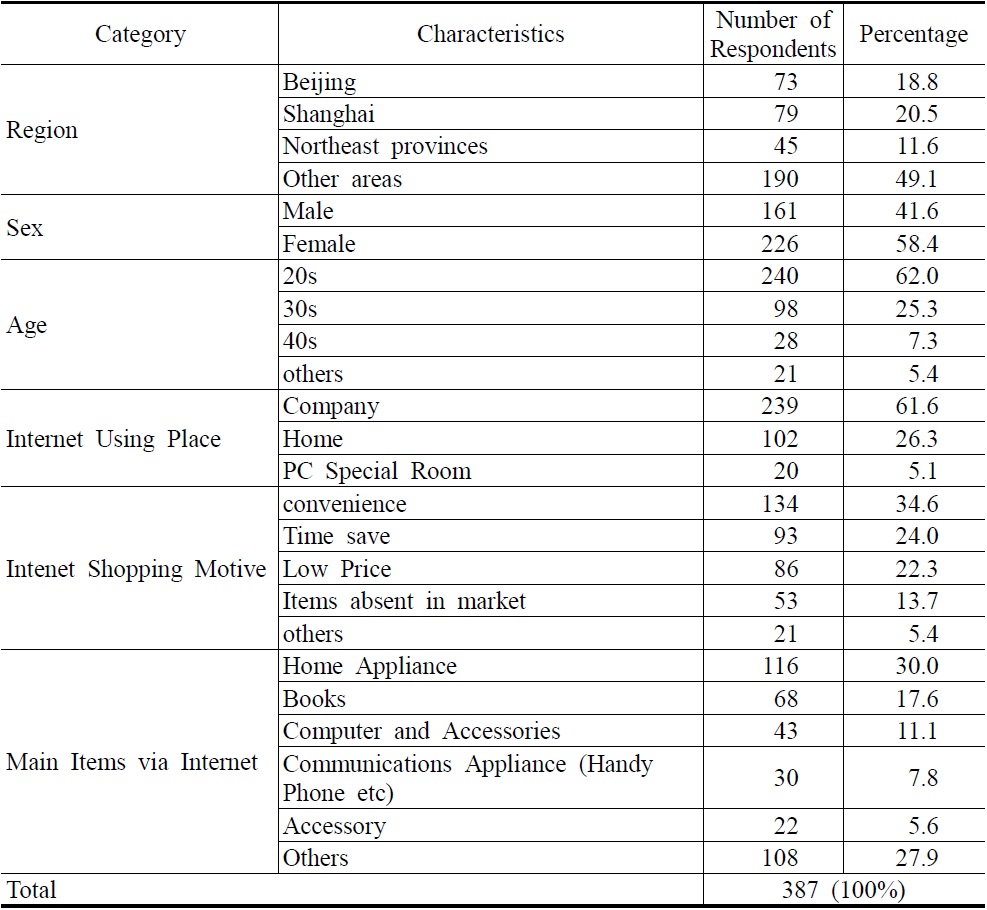
Profile of Respondents
2. Evaluation of the Study Model and Refinement of the Measurement Tool
Before testing our study hypotheses, we evaluated our study model. To do that we conducted a confirmatory factor analysis on our structural equation model. The endogenous variables and exogenous variables were separated before they were tested. The result is illustrated in Figure 3.
The refinement of the measurement tool was considered by using the value of
Reliability refers to the degree which a measure is free from random errors and yields consistent results. The most common method to assess reliability is Cronbach's
In <Table 2>, Cronbach's
The validity refers to the ability of an instrument to measure what it is intended to measure. To enhance validity, we've tested convergent and discriminant validity on our measurement tool. In order for the measurement to have convergent validity, the following criteria must be met; the standardized factor loading must statistically be significant when
As the result is described in <Table 2>, the standardized factor loadings for all attributes are well over 0.5, except REP 3(0.438) which is a little below 0.5. The value of the construct reliability (CR) for all measures is over 0.7, except for tangibility (0.691), and responsiveness (0.626) which are a little below the recommended level. The average variance extracted (AVE) for all measures is over 0.5, except tangibility (0.424) and responsiveness (0.406), which are a little below the recommended level. Therefore, our measurement tool does not have problems with the convergent validity aspect.
[Table 2] Final Confirmatory Factor Analysis
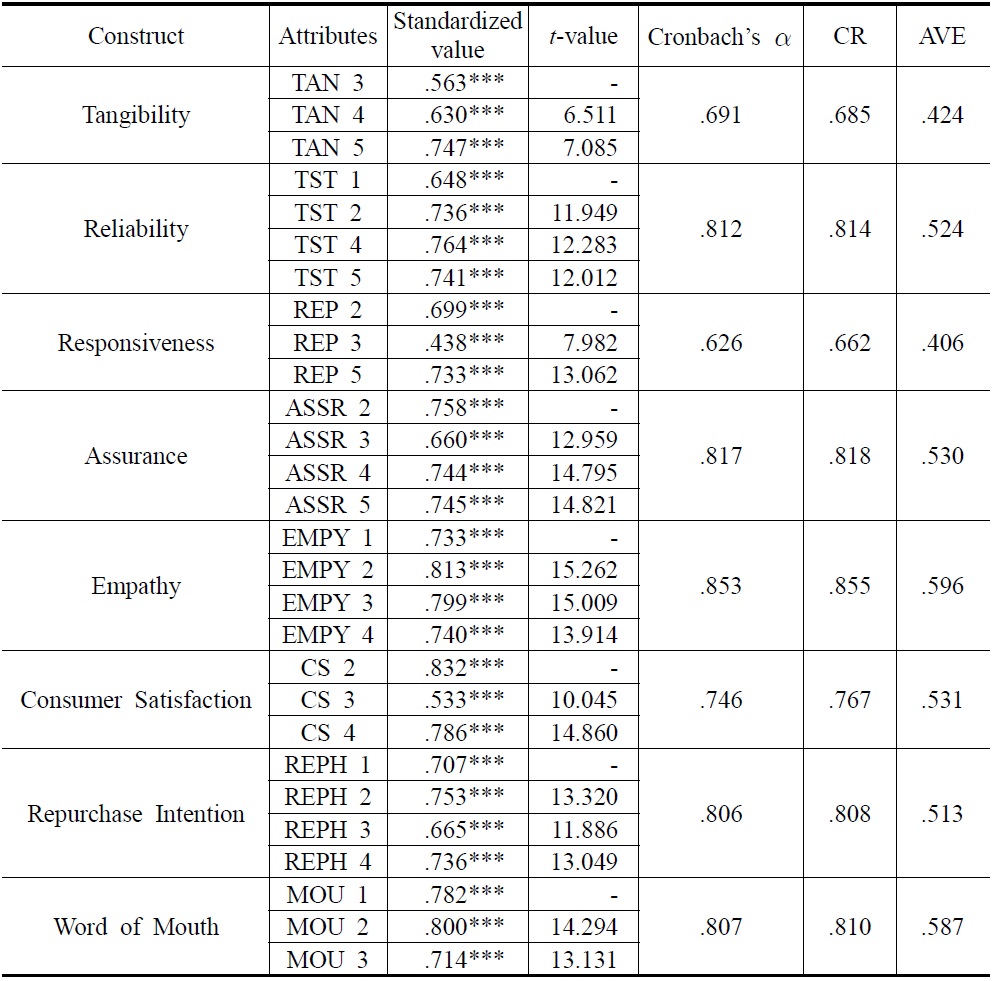
Final Confirmatory Factor Analysis
To test the discriminant validity of the measure, we would like to follow methods suggested by Anderson and Gerbing(1988). The idea is to see whether 1.0 is included in the confidence interval ( Φ±2*
Since our measures got through the series of analyses on goodness of fit, reliability and validity tests, the next step is to test the study hypotheses.
[Table 3] Correlation Analysis
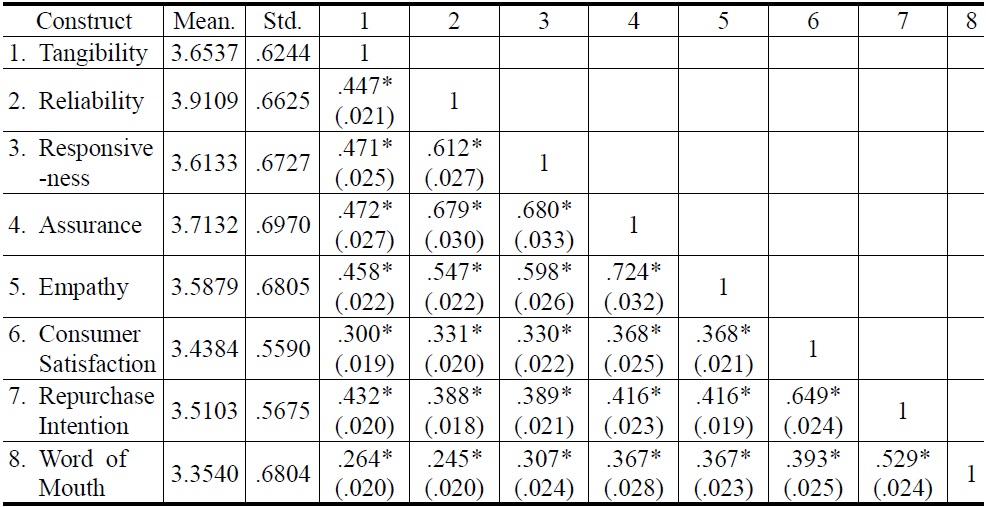
Correlation Analysis
In <Figure 5>, we have illustrated the result of estimating the structural equation model. The values of goodness of fit for the proposed model are:
Hypothesis 1 describes the overall service quality as a good representation of subordinate measures of service quality in which there are tangibility, reliability, responsiveness, assurance, and empathy. The results indicated all subordinate measures, starting from tangibility (standardized path coefficient= 0.756, t-value=fixed), reliability (standardized path coefficient=0.849, t-value= 6.551), responsiveness (standardized path coefficient=0.963, t-value=6.843), assurance (standardized path coefficient=0.981, t-value=7.063), and empathy (standardized path coefficient=0.835, t-value=6.774) are good antecedents, positively influencing the overall measure of service quality. Therefore, hypothesis 1 is supported.
Hypothesis 2 is described as the overall service quality of an Internet shopping mall and is positively associated with consumer satisfaction. The overall service quality (standardized path coefficient=0.272, t-value=2.223) is found to be significantly associated to consumer satisfaction. Thereby our hypothesis 2 is also supported.
Hypothesis 3 and 4 refer to whether the overall service quality influences repurchase intention and word of mouth. The result indicated that the relationship between service quality to repurchase intention (standardized path coefficient= 0.220, t-value=3.673) and word of mouth (standardized path coefficient= 0.244, t-value=3.511) do hold positively. Therefore, in the Chinese Internet shopping mall environment, the overall service quality positively influences not only consumer satisfaction, but also the behavioral intentions of repurchase intention, and word of mouth. Hypotheses 3 and 4 are also supported.
Hypothesis 5 and 6 are based on whether the same relationship holds true between consumer satisfaction and the behavioral intentions of repurchase intention, and word of mouth. The results revealed that consumer satisfaction is positively associated with repurchase intention (standardized path coefficient= 0.731, t-value=10.143). This relationship also holds true for word of mouth (standardized path coefficient=0.442, t-value=6.527). The consumer satisfaction is more strongly bonded to repurchase intention than that of word of mouth. Therefore, consumer satisfaction is the strongest motive for maintaining current customers. In the Chinese Internet shopping environment, the specific and detailed satisfaction strategy must be generated to current customers. One possible reason why word of mouth showed weaker connections than the repurchase intention is that word of mouth is a more active way of representing consumer satisfaction than that of repurchase intention. If repurchase intention is an individual act in which you never have to bother anyone else, but just do it yourself alone. Word of mouth happens when you have to actively meet or socialize with other people.
[Table 4] Hypotheses and Results Summary
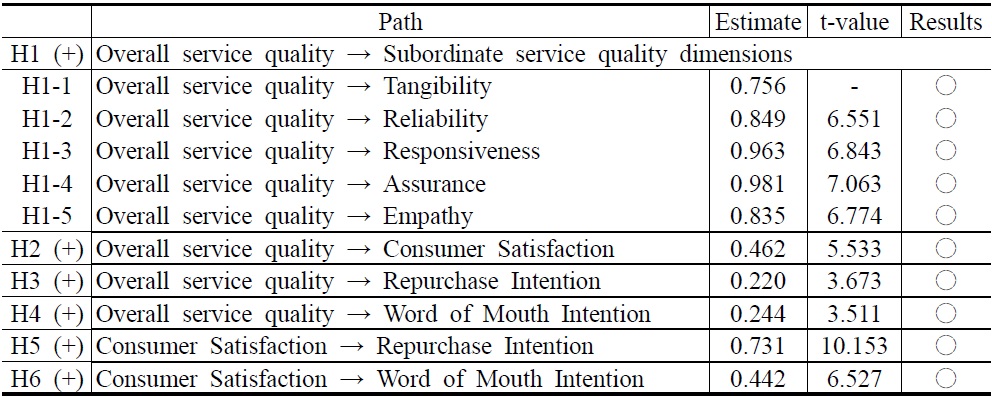
Hypotheses and Results Summary
5. Implications for Korean Shopping Malls
The analyses of the study revealed some significant considerations for Korean dot com companies starting up Internet based business in China in terms of service quality. The market growth for Chinese Internet shopping malls is being continually sustained these days. However, the credibility, distribution channels, security of transactions of information, and payments are the areas which the current study investigated is causing significant problems for the future prospects of the business. The current study not only investigated those low service factors which Chinese Internet shopping customers pointed out, but also contemplates how to reinforce these areas. More detailed implications of this research are described in the following areas.
First, the five subordinates of service quality measure suggested by PZB(1988) in which they are tangibility, reliability, responsiveness, assurance, and empathy do significantly influence the overall measure of service quality. The responsiveness (standardized path coefficient=0.963, t-value=6.843), and assurance (standardized path coefficient=0.981, t-value=7.063) especially stood out from the rest of the subordinates and these two measures may have acted more significantly when forming the overall measure of service quality dimension. This means the current operators of Chinese Internet shopping malls or anyone starting up such businesses in China should pay extra attention to their responsiveness, such as providing quick feedback to consumers about the process of the orders, writing e-mails to them when their orders are completed, or upon the fulfillment of a consumer's request. This is due to the fact that most of today's Internet shopping consumers are composed of 'balinghou (people born after 1980)', whose pattern of consumption is not much different from that of Westerners, following rational and logical buying behaviors. These people also have a good tendency to comparison shop from store to store to search for the products with better value for their money. Thus, keeping regular consumers for good is extremely difficult, because people often switch around between the shopping malls they deal with, without any particular reasons.
At the same time, more attention should be paid in the areas of assurance, such as the security system of the Internet mall, hospitable response to customers, and building customer trust on the information provided. The on-line security can never be overemphasized as vast amounts of personal and sensitive information is collected by the on-line stores and often times this information is hacked. Network security is especially becoming a big issue today in China. In terms of building customer trust with the information being provided to them, there is big discrepancy in the products shown on the advertisement and the products people actually receive, not only in their outer appearances, but also in their quality as well. For instance, in 2008, the Shanghai quality control supervisory office conducted quality investigations on the toys sold through the Internet. The success rate on 58 different product types tested was not even close to 30%, which gave a shocking notice to customers. The consumer trust in the products not only comes from what they seem to be from the outside, but also from the inside quality. Ensuring quality takes time and persistent demonstration. The reliability (standardized path coefficient=0.849, t-value=6.551), empathy (standardized path coefficient= 0.835, t-value=6.774), and tangibility (standardized path coefficient=0.756, t-value=fixed) are all considered as significant compositions for ensuring quality. In terms of reliability, the distribution supporting system is the number one priority. Fast and efficient delivery is mandatory to provide customer orders in right time. Realistically, the infrastructure for distribution in China falls somewhat behind as compared to the advancement of the Internet business. Therefore, although the distribution system may be the most urgent matter to resolve, it's not something that can be done by a single business. The Chinese government and relevant corporations must act together in the long term and settle this problem in a step-by-step manner. At the same time, when you are thinking about starting up a business in China, you must first check to see how efficient the current distribution systems are in the areas of your interest. In terms of empathy, it is extremely important to provide individualized channels to consumers. Having intimate 'quanxi (relationship)' is the most significant factor for anyone doing business in China. Culturally speaking, Chinese people consider building up relationships as an important part of social life. They tend to be extremely kind and do favors for those who are in close relationships with them. Having meals together or giving gifts all belong as part of building up a relationship. The true quanxi with consumers is probably the most crucial factor for developing Internet businesses in China.
Second, the overall measure of service quality does positively influence consumer satisfaction, repurchase intention, and word of mouth. This means that the overall service quality can enhance the outcome performance of Internet shopping malls. The overall service quality enhances repurchase intention and word of mouth through consumer satisfaction. And it can also directly influence on repurchase intention and word of mouth without having to go through the emotional state of consumer satisfaction. Again, consumer satisfaction is proved to be a strong influencer for repurchase intention and word of mouth. The consumer satisfaction in the field of marketing is the difference between a consumer's expectation and product's performance. Having consumers to maintain in positive state of mind is not easy to do all the time. The on-line shopping operators have to develop and think continuously about how to please consumers in order for your performance to exceed the consumer's expectations. This is not something that can be easily achieved.
The current study was conducted in China, a country where Internet shopping is actively progressing. The key variables we've looked at are service quality, consumer satisfaction, and behavioral intention or the repurchase intention and word of mouth.
The summary of our study results are as follows. First, the five subordinates of service quality measure suggested by Parasuraman et al.(1988) or tangibility, reliability, responsiveness, assurance, and empathy do significantly influence the overall measure of service quality. Responsiveness and assurance especially stood out from the rest of the subordinates, and these two measures may have acted more significantly when forming the overall measure of the service quality dimension. This means the host of an Internet shopping mall should pay more attention to responsiveness, such as providing feedback to consumers about the whole order process, writing e-mails when consumer orders are completed, and fulfilling on consumer requests. At the same time, more attention should also be paid in the areas of assurance such, as the security system of the Internet mall, kind responses to consumers, and making the effort to build trust regarding the information being provided to consumers. The security on-line can never be overemphasized as vast amounts of personal and sensitive information are collected by the on-line stores and, often times, we see that this information is hacked.
Second, the overall measure of service quality does positively influence consumer satisfaction, repurchase intention, and word of mouth. This means that the overall service quality can enhance the process in achieving outcomes of Internet shopping malls. The overall service quality enhances repurchase intention and word of mouth through consumer satisfaction. But it can directly influence on repurchase intention and word of mouth without having to go through the emotional state of consumer satisfaction.
Third, again, consumer satisfaction is proved to be a strong influencer in repurchase intention and word of mouth. Consumer satisfaction in the field of marketing is the difference between a consumer's expectations and a product's performance. Therefore, having to maintain consumers in a satisfied state of mind is not easy to do all the time. You, as an on-line shopping host, have to develop something continuously in order for your performance to exceed that of consumer's expectation. This is not something easily achieved.
The contribution of the study is primarily in developing the measurement tool of the service quality for the Internet shopping environment. We hope this research can be a base for further analyses on the comparisons of, or among, different cultures.
Overall, the current study researched whether five subordinates of service dimensions which Parasuraman et al.(1988) suggested can be represented by the overall measure of SERVQUAL. The result of the analyses can usefully be employed for those who are currently doing Internet business in China or those who are about to start one. Korean organizations and entrepreneurs need to understand how these quality aspects of service can be applied to real Internet businesses in China.
